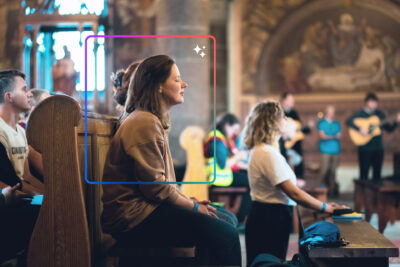
For more than 2,000 years, the Church has faced and overcome many challenges. While recent years have presented more, particularly unprecedented trials, churches are also uniquely equipped with tools and technology that were unimaginable centuries ago. Among these is the church app—a powerful way to keep your community connected, especially during crises. We chatted with David Royall, a Product Marketing Manager at Pushpay, about how a custom church app can help with church management in stressful situations.
Q: David, why is an app important for churches, especially during a crisis?
DR: During a crisis, people constantly check social media for updates. But, using social media as a primary communication platform can result in your messages getting lost in the seemingly never-ending newsfeed. That’s where Pushpay’s church app can help. It allows churches to reach out to people who have already expressed interest in their church and delivers the message directly into their pockets, bypassing the noise of other media.
Q: Can you tell us more about the Pushpay church app’s key features for church leaders during a crisis?
DR: Absolutely. One of the standout features is push notifications. These notifications can be sent to targeted groups of people with important details, like a phone number or a link to a form for volunteering. By personalizing and customizing these notifications, churches can have the most impact during a crisis and ensure they reach the right people with the right message.
Q: What are some best practices for using a church app effectively, especially during a high-stress time or a crisis?
DR: The key is to make sure that whoever is managing the content on the app is connected with the staff who organize volunteer efforts or manage your facilities. Communication is crucial during a crisis, and having accurate information on the app can help alleviate stress and confusion. This ensures that all necessary details are communicated effectively and that the notifications sent aren’t generic but have a real impact. Additionally, using the app to offer resources for mental health support or prayer requests can provide comfort and support to those in need.
Q: Are there any other features of the Pushpay app that churches can use?
DR: Yes, Pushpay’s app also has ChMS features like Public Needs, asking people to volunteer, promoting events, and even a check-in feature. Public Needs is a powerful feature in a crisis, offering a digital public sign-up to empower your community to reach and care for one another.
The check-in feature is commonly used for members to log their attendance at a worship service or event. During a crisis, churches could leverage the check-in feature to encourage their members who are doing okay and available to volunteer, to check-in. Or, flip it and prompt those who need help to check in, making it easier for the church to identify and connect with those in need.
Q: Could you elaborate on the notification categories feature in a church app?
DR: Of course. With Pushpay’s church app, users can opt into different notification categories and choose what communications they want to receive. This way, they’re not inundated with everything for everybody all the time and instead only getting the information they need now.
Q: How does the app help churches stay financially healthy during a crisis?
DR: Many churches rely on donations to continue their important work, but during a crisis, it can be challenging to collect donations in person. You can still have services using livestreams, and churches can easily offer online giving options in the app. And if you’re offering a unique service in response to the crisis and want to raise money for that cause, you could send out a notification asking people to give to a specific campaign.
The Pushpay giving experience is designed to be simple so that even in high-stress situations, people can give easily. It’s not just how quickly it can be done, but how it decreases the cognitive load. We’ve seen that churches who use Pushpay have donors that they never expected to be giving online because it’s simple enough for them.
Q: Can recurring giving be an option during these times?
DR: Absolutely. If you’re unable to meet in person for a long time, or if certain people are unable to come in because they’re impacted by the crisis, recurring giving keeps them connected and engaged in their church community regardless of where they are. The feature also helps your church stay sustainable financially, especially when members or your entire church body can’t gather together for long periods of time.
Q: Can you talk about the security process that Pushpay has to keep funds and data safe?
DR: Pushpay’s products are fully PCI-DSS Compliant as a Level 1 Service Provider. For Giving, all the processing happens outside of the app to keep data like the payment method, and the donor’s information, secure. It happens in a browser just like if you’re on your computer, but in a mobile-friendly version.
Q: How can staff members use the Pushpay app effectively?
DR: Staff members can log into the App Studio and create an item for collecting information through a form and communicating everything your congregation needs to know about volunteering to help. You can put all of that in an item, add that to your dynamic home screen, and then schedule a push notification to go out to your congregation. You can really design that crisis item to be exactly what you need for that situation.
Q: What are some examples of churches successfully using the Pushpay App during a crisis?
Christ’s Church of the Valley is a great example. During COVID-19, we know that the pandemic didn’t only affect people physically. It also created a mental health crisis. In response to the hopelessness or desperation that so many people felt, Christ’s Church of the Valley launched their Press On initiative. Over 4,000 people texted “help” during their campaign, and Christ’s Church of the Valley shared resources and helped pay for those respondents’ first ten counseling sessions.






